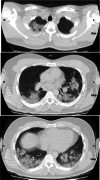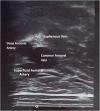A case report of greater saphenous vein thrombosis in a patient with coronavirus (COVID-19) infection
- PMID: 33658082
- PMCID: PMC7928195
- DOI: 10.1186/s40794-021-00131-9
A case report of greater saphenous vein thrombosis in a patient with coronavirus (COVID-19) infection
Abstract
In December 2019, the World Health Organization (WHO) announced a series of pneumonia cases caused by an unknown origin, discovered in Wuhan, China. A dangerous virus called severe acute respiratory syndrome coronavirus 2 (SARS-CoV-2) caused a disease named acute respiratory syndrome, which was later popularly called coronavirus infection (COVID-19). Patients with acute COVID-19 are at high risk of thrombosis in various blood vessels due to hypercoagulability, blood stasis, and endothelial damage. In this study, we present a case report of a patient with COVID-19, who was hospitalized in one of the hospitals in Sanandaj, Iran. There were symptoms of fever, chills, muscle aches, cough, and tachycardia. Laboratory tests showed high levels of CRP, ESR, Ferritin CLIA, LDH and D-Dimer in this patient. Doppler ultrasound of the patient also revealed an abnormal finding, thrombosis in the right greater saphenous vein. This suggests that COVID-19 may lead to other negative effects through damage to blood vessels.
Keywords: COVID-19; Case report; Coronavirus; Superficial vein thrombosis; Ultrasonography.
Conflict of interest statement
All authors declare that there is no conflict of interest that prejudices the impartiality of this scientific work.
Figures


Similar articles
-
Isolated Great Saphenous Vein Thrombosis in a Patient With COVID-19 Infection: Case Report and Review of the Literature.Cureus. 2022 Dec 5;14(12):e32196. doi: 10.7759/cureus.32196. eCollection 2022 Dec. Cureus. 2022. PMID: 36620805 Free PMC article.
-
COVID-19 Presented With Deep Vein Thrombosis: An Unusual Presenting.J Investig Med High Impact Case Rep. 2020 Jan-Dec;8:2324709620931239. doi: 10.1177/2324709620931239. J Investig Med High Impact Case Rep. 2020. PMID: 32493073 Free PMC article.
-
[Severe acute respiratory syndrome coronavirus 2 infection in renal transplant recipients: A case report].Beijing Da Xue Xue Bao Yi Xue Ban. 2020 Aug 18;52(4):780-784. doi: 10.19723/j.issn.1671-167X.2020.04.033. Beijing Da Xue Xue Bao Yi Xue Ban. 2020. PMID: 32773818 Free PMC article. Chinese.
-
A Review of Coronavirus Disease-2019 (COVID-19).Indian J Pediatr. 2020 Apr;87(4):281-286. doi: 10.1007/s12098-020-03263-6. Epub 2020 Mar 13. Indian J Pediatr. 2020. PMID: 32166607 Free PMC article. Review.
-
The origin, transmission and clinical therapies on coronavirus disease 2019 (COVID-19) outbreak - an update on the status.Mil Med Res. 2020 Mar 13;7(1):11. doi: 10.1186/s40779-020-00240-0. Mil Med Res. 2020. PMID: 32169119 Free PMC article. Review.
Cited by
-
Isolated Great Saphenous Vein Thrombosis in a Patient With COVID-19 Infection: Case Report and Review of the Literature.Cureus. 2022 Dec 5;14(12):e32196. doi: 10.7759/cureus.32196. eCollection 2022 Dec. Cureus. 2022. PMID: 36620805 Free PMC article.
-
A Case of Deep Vein Thrombosis After Recovery From COVID-19 and Its Association With Elevated D-dimers.Cureus. 2022 Oct 3;14(10):e29859. doi: 10.7759/cureus.29859. eCollection 2022 Oct. Cureus. 2022. PMID: 36337799 Free PMC article.
-
Superficial venous thrombosisas a possible consequence of ChAdOx1 nCoV-19 vaccine: two case reports.J Med Case Rep. 2022 May 7;16(1):182. doi: 10.1186/s13256-022-03407-6. J Med Case Rep. 2022. PMID: 35524323 Free PMC article.
References
-
- Sobreira ML, et al. Prevalence of deep vein thrombosis and pulmonary embolism in superficial thrombophlebitis of the lower limbs: prospective study of 60 cases. Int Angiol. 2009;28(5):400. - PubMed
LinkOut - more resources
Full Text Sources
Other Literature Sources
Research Materials
Miscellaneous

